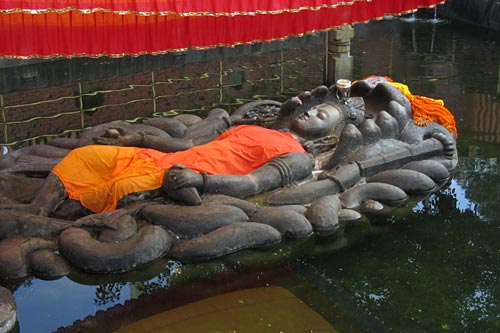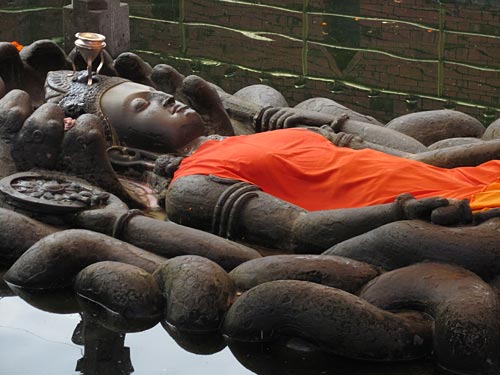About Budhanilkantha Temple
The Budhanilkantha statue of the Hindu god Vishnu, located
approximately 10 kilometers from the center of Kathmandu at the base of
the Shivapuri Hill, is the largest and most beautiful stone carving in
all of Nepal. It is also the most enigmatic.
Carved from a single block of black basalt stone of unknown origin,
the Budhanilkantha statue is 5 meters in length and it lies in a
reclining position inside a recessed tank of water (representing the
cosmic sea) that is 13 meters in length. Called the Sleeping Vishnu, or
Jalakshayan Narayan, the statue depicts the deity reclining on the
twisting coils of the cosmic serpent Shesha (Shesha is the eternal,
multi-headed king of the serpent deities known as Nagas, and also is the
servant of Vishnu). Vishnu’s legs are crossed and the eleven heads of
Shesha cradle his head. Vishnu’s four hands hold objects that are
symbols of his divine qualities: a chakra or disc (representing the
mind), a conch-shell (the four elements), a lotus flower (the moving
universe) and the club (primeval knowledge).

Budhanilkantha literally means “old blue-throat’ and how it got that
name is fascinating, as explained by the excellent Rough Guide to Nepal:
“Budhanilkatha’s name has been a source of endless confusion. It has nothing to do with the Buddha (budha
means “old”, though that doesn’t stop Buddhist Newars – a particular
sect of Nepalese Buddhists - from worshipping the image). The real
puzzler is why Budhanilkantha (literally “Old Blue Throat”), a title
which unquestionably refers to Shiva, has been attached here to Vishnu.
The myth of Shiva’s blue throat, a favorite in Nepal, relates how the
gods churned the ocean of existence and inadvertently unleashed a poison
that threatened to destroy the world. They begged Shiva to save them
from their blunder and he obliged by drinking the poison. His throat
burning, the great god flew up to the range north of Kathmandu, struck
the mountainside with his trident to create a lake, Gosainkund, and
quenched his thirst – suffering no lasting ill effect except for a blue
patch on his throat. The water in the Sleeping Vishnu’s tank is
popularly believed to originate in Gosainkund, and Shaivas claim a
reclining image of Shiva can be seen under the waters of the lake during
the annual Shiva festival there in August, which perhaps explains the
association. Local legend maintains that a mirror-like statue of Shiva
lies on the statue’s underside.”
Two old stories offer differing explanations of the origin of the
Budhanilkantha statue. One says that the statue was sculpted and brought
(by devotees or forced labor) to its current location in Kathmandu
during the reign of the seventh-century monarch Vishnugupta, who
controlled the Kathmandu valley under the Licchavi king Bhimarjunadev.

An alternate legend relates that in times past a farmer and his wife
occupied a farm in an (unspecified) area and while cultivating the land
they struck the Deity. Immediately afterwards blood began to flow from
the ground and thus the lost deity of Budhanilkantha was recovered and
placed in its rightful position.
Whatever the actual source of the statue and the time of its
creation, it is known that for much of its history it was considered a
representation of Vishnu. This is understandable, given the fact that
the main sect of Hinduism in Nepal was Vaishnavism, or the worship of
Vishnu. At different times, however, for example in the 12th and 13th
centuries of the Malla Dynasty, when Shiva became the most popular
deity, the Budhanilkantha was not so revered.
In the late 14th century, the Malla king Jayasthitihi (1382–1395) is
credited with reviving the Vishnu cult by claiming to be the latest
incarnation of this often-incarnated god. Subsequent kings of Nepal,
most notably Pratap Malla (1641-1674) have made the same claim.
According to a story originating from this time, Pratap Malla had a
prophetic vision, which resulted in his strong belief and fear that
should the King of Nepal visit the Budhanilkantha temple, death would be
imminent upon his departure. Continuing to this day the Hindu Kings of
Nepal will not visit the temple. The devotional practice of other Hindus
is to approach Vishnu’s feet and, after touching them, make prayers
and/or give thanks to the god (but it is forbidden for foreign visitors
to do this).
Budhanilkantha has become the site on which Haribondhini Ekadashi
takes place during the 11th day of the Hindu month of Kartik (October –
November). Attended by many thousands of pilgrims, it is the principle
festival for the year in celebration of the awakening of Lord Vishnu
from his long sleep.
It is interesting to note that two other examples of the enormous
stone carvings of the Sleeping Vishnu exist in the city of Kathmandu.
One, which may be viewed by the general public, lies five kilometers
northwest of the city center in the Balaju Gardens. The other, which may
not be viewed by the public, is at the Royal Palace.
-source: sacredsites.com


0 comments
Write Down Your Responses